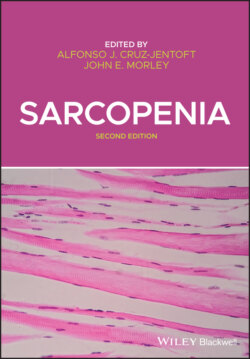Читать книгу Sarcopenia - Группа авторов - Страница 45
OVERVIEW OF THE NEUROMUSCULAR SYSTEM
ОглавлениеTo fully appreciate the contribution of motor unit (MU) remodeling to sarcopenia, a reminder of the basic structure and function of the neuromuscular system is described. The human body is made up of over 500 skeletal muscles [1]. Each individual MU consists of a neuron, its axon and the muscle fibers it innervates. Wrapping around the axon are Schwann cells to form a myelinated sheath and promote the conduction of motor nerve action potentials. In the limited space between the motor neuron terminal and the muscle fiber, sits the neuromuscular junction. This junction, or chemical synapse, allows signals to be translated from neurons to muscle cells via neurotransmitter release and receptor binding.
At the structural level, there are three types of muscle fibers involved in contraction: type I, type IIa, and type IIx. These phenotypes contain differing physiological properties; for example, type I fibers (slow‐twitch) are highly oxidative and possess a low capacity to generate adenosine triphosphate (ATP). In comparison, type IIa fibers are fast‐twitch, carry high ATP and glycolytic capacity, and are fatigue resistant. Type IIx fibers (also fast‐twitch) have the highest ATP generating capacity but lowest glycolytic capacity and fatigue rapidly [2]. Notably, many fibers can express more than one isoform of myosin heavy chain (MHC) and are referred to as hybrid fibers. Stacks of muscle fibers (known as myofibrils), contain sarcomeres and are made up of two main contractile proteins: actin (thin) and myosin (thick). Each myosin is made up of two myosin heads arranged longitudinally with ATP and actin binding sites. Actin, like myosin, has a double helix structure; however, it has additional protein structures, namely troponin and tropomyosin. The former enables calcium (Ca2+) to bind, while the latter blocks the binding site of actin.
The nervous system regulates MU recruitment and allows an older adult to carry out a range of movements from fast and powerful (i.e., stairs climbing) to small and subtle (writing). To enable this energy dependent process, action potentials are first generated in the motor cortex of the brain and are then transmitted via the spinal cord into the MU pool. At the peripheral level, this action potential further propagates down motor axons to the neuromuscular junction (NMJ), then throughout muscle fibers down into the transverse tubular system, which in turn, activates ryanodine receptors causing the release of Ca2+ ions from the sarcoplasmic reticulum and enables structural proteins to contract. These electrophysiological processes are highly energy dependent and any disruption to the structure or function of MU will impede force production.
